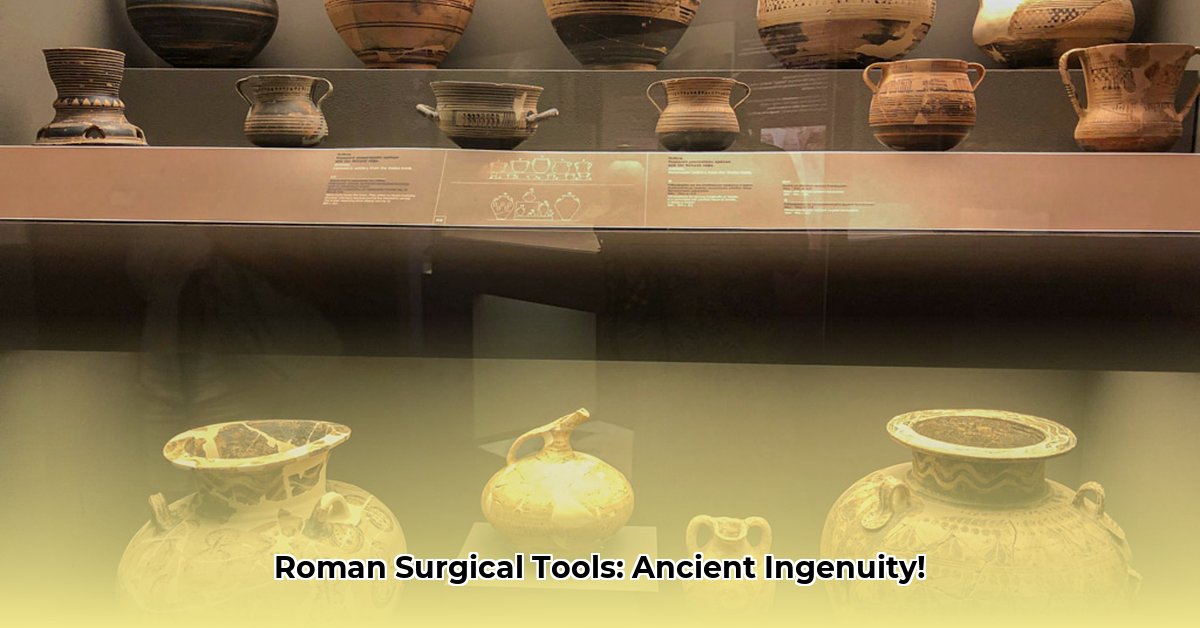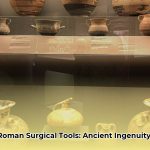Imagine stepping back in time, not to a world devoid of scientific understanding, but to an era where ingenuity and adaptation defined medical practice. Though the Romans lacked our modern comprehension of germ theory or advanced anatomy, ancient Roman surgeons were remarkably resourceful, leaving behind a compelling legacy of surgical innovation. For further insight, explore Roman surgery. A comprehensive examination of ancient Roman surgical instruments provides a vivid window into their world, revealing their impressive skill in tool design, thoughtful material selection, and surprisingly sophisticated surgical methodologies. From the bustling military camps to the quiet domestic sphere, these early healers navigated the complexities of the human body with an impressive array of tools and a pragmatic approach to medicine.
The Intellectual Bedrock: Greek Influence and Roman Adaptation
Roman medicine, though inherently practical and focused on observable outcomes, did not originate in a vacuum. It was profoundly shaped by the intellectual bedrock laid by earlier Greek physicians. Figures like Hippocrates, often hailed as the “Father of Medicine,” and Galen, whose extensive anatomical and physiological writings dominated Western medical thought for centuries, provided theoretical frameworks that Roman practitioners eagerly adopted and adapted.
The Greek holistic approach, encompassing both mind and body, resonated deeply with Roman sensibilities. Key concepts such as humorism—the belief that health stemmed from a balance of four bodily humors—were embraced, even as Roman doctors developed their own emphasis on anatomical studies and logical reasoning for diagnosis. This synthesis of Greek theory with Roman practicality led to a unique medical system. Roman medical theory prioritized observation of disease progression and an emphasis on natural remedies, diet, and exercise to restore the body’s equilibrium. This blend of inherited wisdom and applied innovation set the stage for their remarkable surgical advancements.
The Roman Surgeon’s Comprehensive Arsenal: Tools and Their Purpose
Roman surgeons were equipped with a surprisingly diverse and specialized toolkit, reflecting a nuanced understanding of anatomical needs and surgical procedures. Archaeological discoveries, particularly the extensive collection found remarkably preserved in Pompeii’s House of the Surgeon, alongside surviving medical texts, reveal an impressive array of Roman surgical tools, each meticulously designed for a specific function.
- Scalpels: Echoing modern surgical practices, Roman surgeons utilized diverse blades for varied tasks. Long, steel scalpels were suited for deep or extended incisions, while smaller, bellied bronze scalpels allowed for delicate and precise cuts.
- Forceps: These indispensable instruments were crucial for grasping tissues, clamping blood vessels, and extracting foreign bodies. They exhibited a range of shapes and sizes, from general-purpose grippers to finely toothed instruments, and were also used for epilation or by artists, demonstrating their multi-functional nature.
- Bone Instruments: To address fractures, remove diseased bone tissue, or perform necessary amputations, surgeons employed rudimentary drills, saws, and bone levers (known as vectis). Bone drills, often driven by a thong for rotary motion, were used for trephination—cutting holes in the skull—and removing foreign objects. Bone forceps were essential for extracting small fragments of bone otherwise difficult to grasp.
- Specula: Among the most complex and distinctive Roman instruments were the dilators, or specula, notably the vaginal speculum (dioptra) and the rectal speculum. These devices, often featuring screw mechanisms to open dovetailing valves, allowed for internal examination, diagnosis, and treatment of various disorders, a design that remarkably persisted with little change until modern times. Soranus, a Greek gynecologist, notably described the vaginal speculum, and Hippocrates mentioned the rectal speculum.
- Cautery Tools: Instruments designed to apply heat (cauteries) were employed to an astonishing extent. They were vital for sealing blood vessels (hemostasis), acting as a bloodless knife, destroying tumors, and serving as a counter-irritant. Their varied forms underscore the ingenuity surgeons invested in this critical instrument for bleeding control and tissue removal.
- Hooks: Both blunt and sharp hooks were common. Blunt hooks served as probes for dissection and for raising blood vessels, similar to modern aneurysm needles. Sharp hooks were used for seizing and lifting small pieces of tissue for excision and for retracting the edges of wounds, often performing manipulations now done with dissecting forceps.
- Probes and Curettes: Instruments like the spathomele (a long shaft with an olivary point and a spatula) and the cyathiscomele (similar, but sometimes adapted as a curette) were primarily pharmaceutical, used for mixing, measuring, and applying medicaments. The olive end stirred compounds, while the spatula spread them. Their large numbers suggest widespread use beyond medical professionals, possibly by painters for mixing colors.
- Catheters: Hollow tubes, typically made of steel or bronze, catheters were designed to open blocked urinary tracts. They came in slightly curved “S” shapes for male patients and straighter forms for females, showcasing an awareness of anatomical differences.
- Uvula Crushing Forceps: These specialized forceps, mentioned by Hippocrates, were designed to crush the uvula before amputation to prevent hemorrhage, highlighting a specific, delicate procedure.
| Instrument | Primary Function | Common Materials |
|---|---|---|
| Scalpel | Performing incisions, excisions, and dissections; varying forms for precision and depth. | Iron, Steel, Bronze |
| Forceps | Gripping tissues, removing foreign objects, clamping vessels; diverse shapes and sizes for specific applications, including uvula crushing. | Iron, Steel, Bronze |
| Bone Drill | Creating precise holes in bone, particularly for trephination (relieving pressure on the brain) or removing foreign objects embedded in bone. | Iron, Steel |
| Bone Saw | Executing amputations to prevent infection, gangrene, or in cases of severe trauma; segmenting bones for removal. | Iron, Steel |
| Vectis (Bone Lever) | Levering fractured bones into place, raising depressed bone fragments, or sometimes assisting with tooth extractions; often ridged for better grip. | Iron, Steel |
| Vaginal Speculum | Facilitating internal examination of the vaginal canal and uterus for diagnosis and treatment of gynecological conditions; screw mechanism for adjustable opening. | Bronze |
| Rectal Speculum | Examining the rectal area, especially for conditions like fistulas. | Bronze |
| Cautery Iron | Sealing blood vessels (hemostasis), excising tumors, acting as a bloodless knife, or for counter-irritation; various shapes for different applications of controlled heat. | Iron, Bronze |
| Hooks (Blunt & Sharp) | Blunt: Dissecting, raising blood vessels; Sharp: Seizing and raising small pieces of tissue for excision, fixing and retracting wound edges. | Bronze, Iron |
| Probes & Curettes | Exploring wounds or ulcers, acting as sounds, and primarily for mixing, measuring, and applying medicaments; some adapted for scraping. | Bronze, Iron |
| Catheters | Opening up blocked urinary tracts to allow urine passage; designed with specific curves for male and female patients. | Steel, Bronze |
| Spathomele | Pharmaceutical instrument with an olivary point and spatula, used for stirring and spreading medicaments; also used by painters for mixing colors. | Bronze, Iron |
| Cyathiscomele | Similar to spathomele, with a cup-like end, used for mixing, measuring, and applying medicaments; some adapted as curettes, indicating broad use. | Bronze, Iron |
| Ligatures | Used to tie off blood vessels, a crucial method for controlling hemorrhage, especially during amputations or in treating deep wounds. | Flax, Hemp, Animal Sinew |
| Suture Needles & Thread | Stitching up wounds and closing incisions; needles often made of bone or metal, with threads from natural fibers to promote healing and reduce infection. | Bone, Metal (Flax, Hemp) |
| Cupping Vessels | Applied to the body to draw blood or fluids, used for larger areas (back, thighs) or smaller areas (arms); believed to relieve internal congestion or pain. | Bronze, Glass |
| Tube Inserts | Inserted into nose, rectum, or vagina after operations to prevent contraction or adhesion, and to convey medicaments; typically made of lead or bronze. | Lead, Bronze |
Crafting Durability: Materials, Manufacturing, and the Quest for Precision
The fabrication of surgical instruments in ancient Rome was a testament to skilled artisanship and a surprisingly sophisticated understanding of metallurgy. Craftsmen utilized techniques such as forging, hammering, and polishing to transform raw metals into precise, functional tools. Metals like bronze (an alloy of copper and tin), iron, and, less commonly, steel were the preferred materials. Bronze, readily available and workable, was common in earlier periods, while iron and steel, though more challenging to produce, offered superior strength and edge retention crucial for cutting instruments. Occasionally, handles were crafted from durable organic materials like ivory or bone, providing a firm grip and ergonomic comfort, sometimes combined with metal components.
This dedication to quality control and standardization suggests that Roman surgeons valued reliable and consistent instruments. Despite their seeming simplicity by modern standards, the manufacturing processes were intricate, requiring fine detailing to create sharp, pointed edges and smooth surfaces necessary for effective surgery. The archaeological record shows that many instruments, such as the vaginal speculum, were large and robust, testifying to their significant bronze content, making them more likely to be recycled for their material value than smaller, thinner instruments.
Battling the Unseen: Early Hygiene, Sterilization, and Pain Management
One of the most profound limitations faced by Roman surgeons was the complete absence of germ theory. Without an understanding of microorganisms, post-operative infections posed a constant, formidable threat. However, Roman practitioners empirically recognized the importance of cleanliness and implemented pragmatic, if rudimentary, hygiene efforts.
Historical accounts suggest various attempts to mitigate contamination:
* Cleaning Instruments: Surgical instruments were typically cleaned with water and linen, and some evidence indicates that boiling instruments was practiced when resources allowed, utilizing boiling water or steam to kill pathogens.
* Wound Care: Wounds were often rinsed with substances possessing mild antiseptic properties, such as wine or vinegar, and dressed with honey, which has natural antimicrobial qualities.
* Environmental Awareness: While they didn’t understand bacteria, Romans had a general awareness that certain environments, like stagnant water, could promote disease, leading them to take steps to avoid such situations.
Despite these earnest efforts, the efficacy of these methods was inherently limited. The absence of comprehensive sterilization protocols significantly impacted the overall success rates of surgical interventions, making every procedure a high-stakes gamble against infection.
Pain management was another formidable challenge. Roman surgeons employed various options, primarily herbal sedatives. Mandrake, hemlock, and opium were among the most common plant-based anesthetics. These were often combined with wine, potentially enhancing their sedative effects. Additionally, physical cooling of the patient or acupuncture-like techniques were sometimes used to numb specific areas. Despite these attempts, surgery remained a deeply painful and dangerous ordeal, underscoring the resilience of both patient and practitioner in ancient times.
The Military Imperative: War’s Role in Surgical Evolution
The Roman army, a colossal force that forged an empire, inadvertently became a pivotal driver in the evolution of surgery. In the brutal realities of the battlefield, the immediate and effective treatment of injuries became an absolute imperative. This constant pressure not only fostered innovation in surgical techniques but, more crucially, significantly advanced the design and sophistication of ancient Roman surgical instruments.
The Roman army systematically established permanent military hospitals, known as valetudinaria, strategically located near active battlefields and fortified garrisons. These institutions transcended mere convalescent homes; they functioned as dynamic centers of medical practice. Here, military surgeons (medici or chirurgi) amassed invaluable practical experience treating an extensive spectrum of traumatic injuries, from complex fractures and deep penetrating wounds to the devastating effects of projectiles like arrows. The high volume and diversity of cases, coupled with the critical objective of returning soldiers to active duty swiftly, created a unique, high-pressure environment conducive to surgical innovation and specialization. Findings of specific Roman surgical instruments at sites of former military hospitals, such as those unearthed at Baden, Switzerland, unequivocally demonstrate this direct link between military necessity and medical progress.
Roman military medicine embraced principles of immediacy and practical expectancy, essentially a proto-modern approach to battlefield triage. Wounded soldiers underwent rapid assessment to determine who could be saved and who required immediate, life-saving attention. This pragmatic methodology, born directly from dire necessity, significantly foreshadowed the development of modern battlefield triage systems. Operational efficiency was paramount, a factor that profoundly shaped military influence on ancient Roman surgery – toolkit advancements. Beyond military personnel, specialist arena surgeons also honed their skills by repairing valuable gladiators, further advancing trauma care.
The Path to Mastery: Roman Surgical Education through Apprenticeship
How, then, did an individual become a skilled surgeon in ancient Rome? The concept of formal medical schools, as we understand them today, was non-existent. Instead, Roman surgeons learned through an apprentice-based system, the predominant method of education and skill acquisition. Aspiring surgeons typically apprenticed themselves to established, experienced practitioners. They acquired their trade through direct observation, active participation as assistants, and eventually, supervised independent practice. This intimate, hands-on method ensured the direct transmission of medical knowledge and practical skills, integrating established Greek medical wisdom directly into Roman surgical practices.
The profound Roman adoption of Greek medicine played a formative role in shaping their surgical training methodologies. Greek medical texts, established techniques, and philosophical underpinnings formed the bedrock of their evolving medical knowledge system. Aspiring Roman surgeons meticulously studied these foundational teachings, frequently adapting and refining them to suit their unique needs and practical experiences. This cultural fusion resulted in a distinctive blend of theoretical comprehension and applied practical skill.
Despite the rigor of the apprenticeship system, the absence of a formal licensing system for medical practitioners created a fragmented landscape. While some surgeons exhibited exceptional skill and adhered to high ethical standards, others were, regrettably, less competent or scrupulous. This inherent inconsistency inevitably eroded public trust, as patients often faced uncertainty regarding the quality of care they would receive.
Intriguingly, even within ancient Roman medical practice, discernible hints of specialization began to emerge. Some surgeons dedicated their expertise to specific medical disciplines, such as ophthalmology (eye care) or urology (urinary tract conditions). The cultivation of expertise within a niche area suggests a developing, albeit informal, system where specific skills were actively encouraged and valued.
Beyond the Operating Table: Diverse Applications of Roman Medical Care
Roman surgical skills extended far beyond the battlefield, encompassing a wide array of domestic and public health applications.
- Domestic Medicine: Surgeons frequently assisted in obstetric procedures, treating common ailments such as hemorrhoids, bladder stones (which could be










